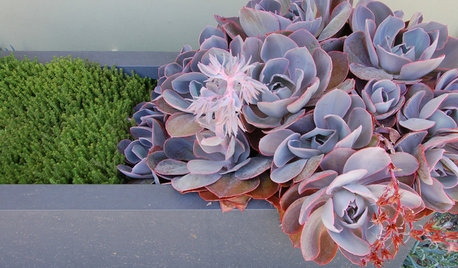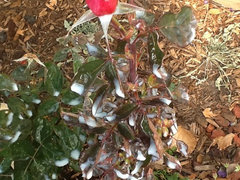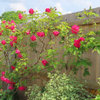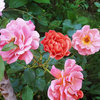milk/water mix for mildew?
bebba1
13 years ago
Featured Answer
Sort by:Oldest
Comments (31)
kstrong
13 years agolast modified: 9 years agoJeannie Cochell
13 years agolast modified: 9 years agoRelated Discussions
Recipe for baking soda/milk powdery mildew spray?
Comments (2)one quart water, one teaspoon baking soda, 1 or 2 drops dish liquid. good air flow helps keep away powdery mildew, so removing nearbly plants, raising or trellising the vines, and keeping the grass cut might help....See MoreWatering milk jugs...
Comments (15)If the containers are frozen they might look dry but not be dry. The moisture will be released as the container thaws. If the containers are not frozen and look dry, no condensation, then they will need to be watered. For me, bottom watering works the best and the bigger the container used for water the more jugs/2Ls will fit inside and less time it will take. I tried using my misting setting on the water wand but found that the jugs weren't adequately watered. And it took a long time when I had lots of jugs. Bottom watering took less time and attention as one can do other things while the containers are soaking in the water. A kitty litter pan wlll hold about 6 jugs. I use an al. 12 qt. tub as that is what I had in my garage. I like the idea of a kiddie pool like Trudi uses and have been watching the curbs on g day for one. Also using a timer and sprinkler as Trudi suggests should work well. Though I haven't looked into this option because I have no outside electrical plugs and assume that one needs electricity to make that work. Once the tops are completely off or open I use a watering wand on shower at low pressure. That low pressure thing is very important as don't want to blast the seeds/seedlings....See MorePowdery Mildew and Milk
Comments (3)Hi SCG I've used milk for powdery mildew on my lilacs with success. It's the only thing I've had to use it on. For some reason I think I remember reading something that said not to use skim milk??...See MoreClarification on spraying "recipe"
Comments (11)This a link to Jeff Gillman's web page. http://www.jeffgillman.net/index.html When I do a Google search for milk and rose black spot, I often get directed to research by Jeff Gillman. Apparently, he has not published it in a reviewed scientific journal, but instead posted the summary here: http://www.jeffgillman.net/5.html " When we tested milk against other home remedies it beat everything else easily. In fact, it was just about as good as the synthetic fungicide Chlorotalonil and the organic fungicide Bordeaux mix" The article apparently was reported in this link: http://www.extension.umn.edu/projects/yardandgarden/YGLNews/YGLNewsApril12008.html But, that link no longer works for me. " Jeff Gillman says: December 24, 2010 at 12:00 am Along with some colleagues here at UMN I have done some work with milk and blackspot on rose — you can read about it here http://www.extension.umn.edu/projects/yardandgarden/YGLNews/YGLNewsApril12008.html It’s the second to last article. " The above quote is from: http://gardenprofessors.com/unintended-consequences/...See Morekarl_bapst_rosenut
13 years agolast modified: 9 years agohenry_kuska
13 years agolast modified: 9 years agoIanW Zone 5 Ont. Can.
13 years agolast modified: 9 years agokstrong
13 years agolast modified: 9 years agogreenhaven
13 years agolast modified: 9 years agoroseman
13 years agolast modified: 9 years agohenry_kuska
13 years agolast modified: 9 years agokstrong
13 years agolast modified: 9 years agojim1961 / Central Pennsylvania / Zone 6
13 years agolast modified: 9 years agohenry_kuska
13 years agolast modified: 9 years agoprofessorroush
13 years agolast modified: 9 years agokstrong
13 years agolast modified: 9 years agohenry_kuska
13 years agolast modified: 9 years agokstrong
13 years agolast modified: 9 years agohenry_kuska
13 years agolast modified: 9 years agokstrong
13 years agolast modified: 9 years agomrlike2u
13 years agolast modified: 9 years agohenry_kuska
13 years agolast modified: 9 years agohenry_kuska
13 years agolast modified: 9 years agohenry_kuska
13 years agolast modified: 9 years agohenry_kuska
13 years agolast modified: 9 years agohenry_kuska
8 years agoprairie_northrose (3b north of Calgary AB, Canada)
8 years agolast modified: 8 years agoprairie_northrose (3b north of Calgary AB, Canada)
8 years agolast modified: 8 years agojim1961 / Central Pennsylvania / Zone 6
8 years agoprairie_northrose (3b north of Calgary AB, Canada)
8 years agolast modified: 8 years ago
Related Stories

PAINTINGWhat to Know About Milk Paint and Chalk Paint — and How to Use Them
Learn the pros, cons, cost and more for these two easy-to-use paints that are great for giving furniture a vintage look
Full Story
SAVING WATERXeriscape Gardens: How to Get a Beautiful Landscape With Less Water
Conserve water and make gardening much easier with the xeriscape approach’s 7 principles
Full Story
LIFEThe Top 5 Ways to Save Water at Home
Get on the fast track to preserving a valuable resource and saving money too with these smart, effective strategies
Full Story
GARDENING GUIDES6 Plants for Colorful Fall Foliage in the Water-Wise Western Garden
Try these colorful, drought-tolerant additions to your garden for a fall season filled with color
Full Story
DECORATING PROJECTSFashion a Greens-Laden Tablescape for Spring
Pair lush greenery and flowers with milk glass for an arrangement that will make any meal memorable
Full Story
DECORATING GUIDESWarm Up Your Room With a Farmhouse Find
Milking stools, orchard ladders and farm tables add a rustic touch to contemporary, industrial and midcentury spaces
Full Story
HOUZZ TOURSMy Houzz: Turning a Netherlands Barn Into a Country Home
Once a place for chilling milk, this Dutch home now lets the owners chill out in easygoing comfort
Full Story
SUCCULENTSGrow a Garden of Succulents for Easy Beauty
Low-water plants in a wide range of colors, shapes and sizes? Sign us up — and check out our faves here
Full Story
LANDSCAPE DESIGN15 Great Ideas for a Lawn-Free Yard
End the turf war for good with hardscaping, native grasses and ground covers that save water and are easier to maintain
Full Story
KITCHEN DESIGNWonderful Wood Countertops for Kitchen and Bath
Yes, you can enjoy beautifully warm wood counters near water sans worry (almost), with the right type of wood and sealer
Full Story












prairie_northrose (3b north of Calgary AB, Canada)